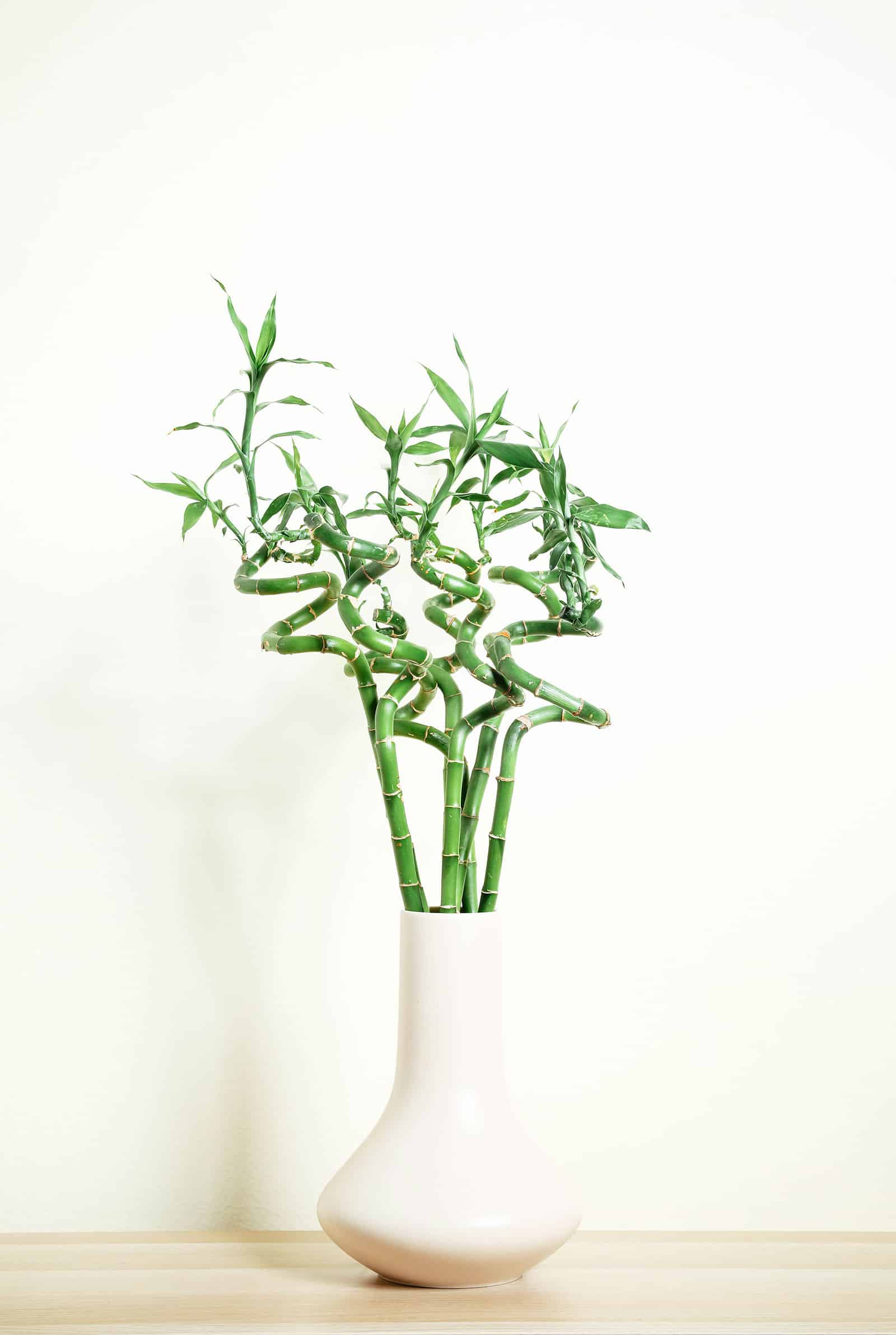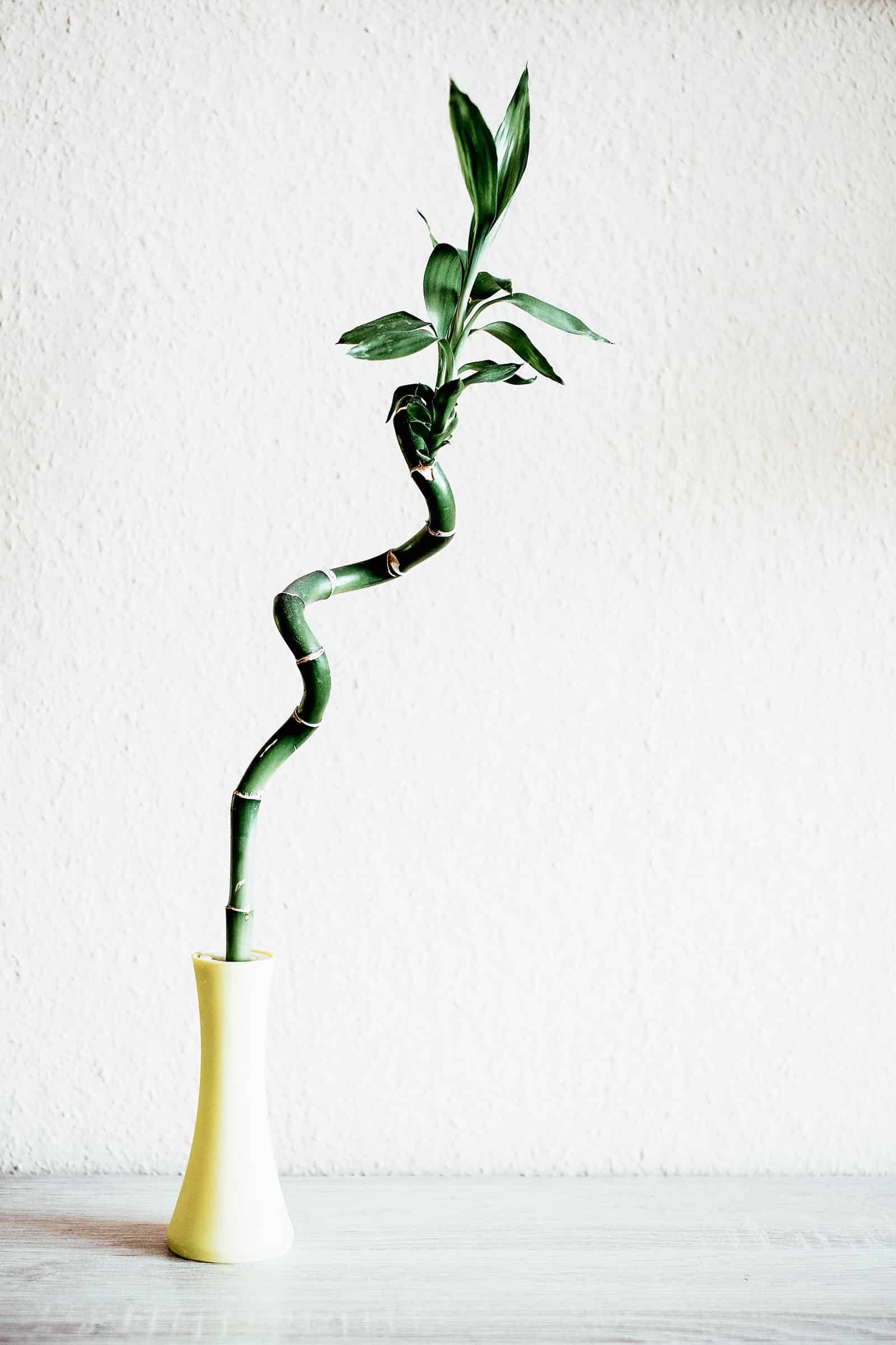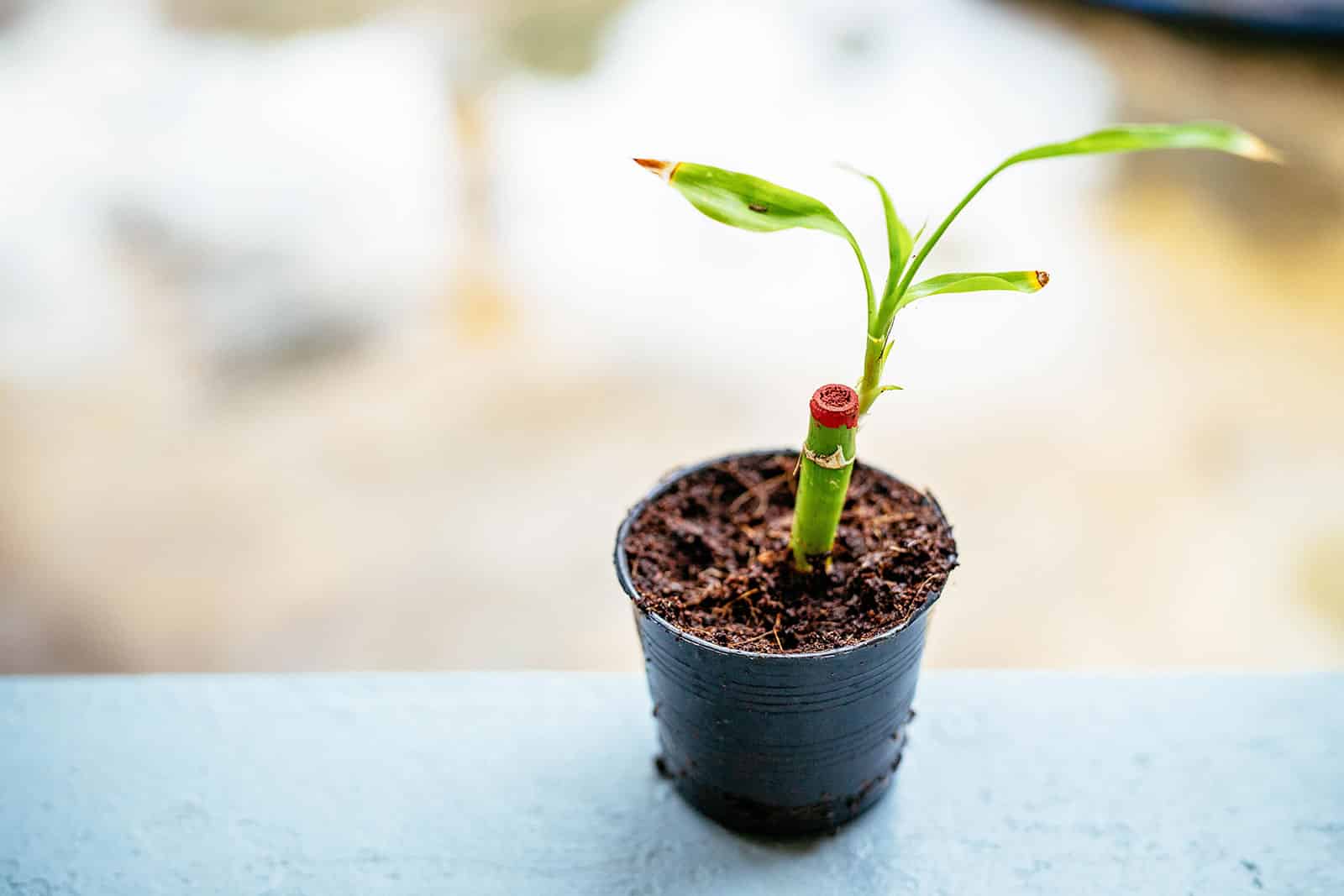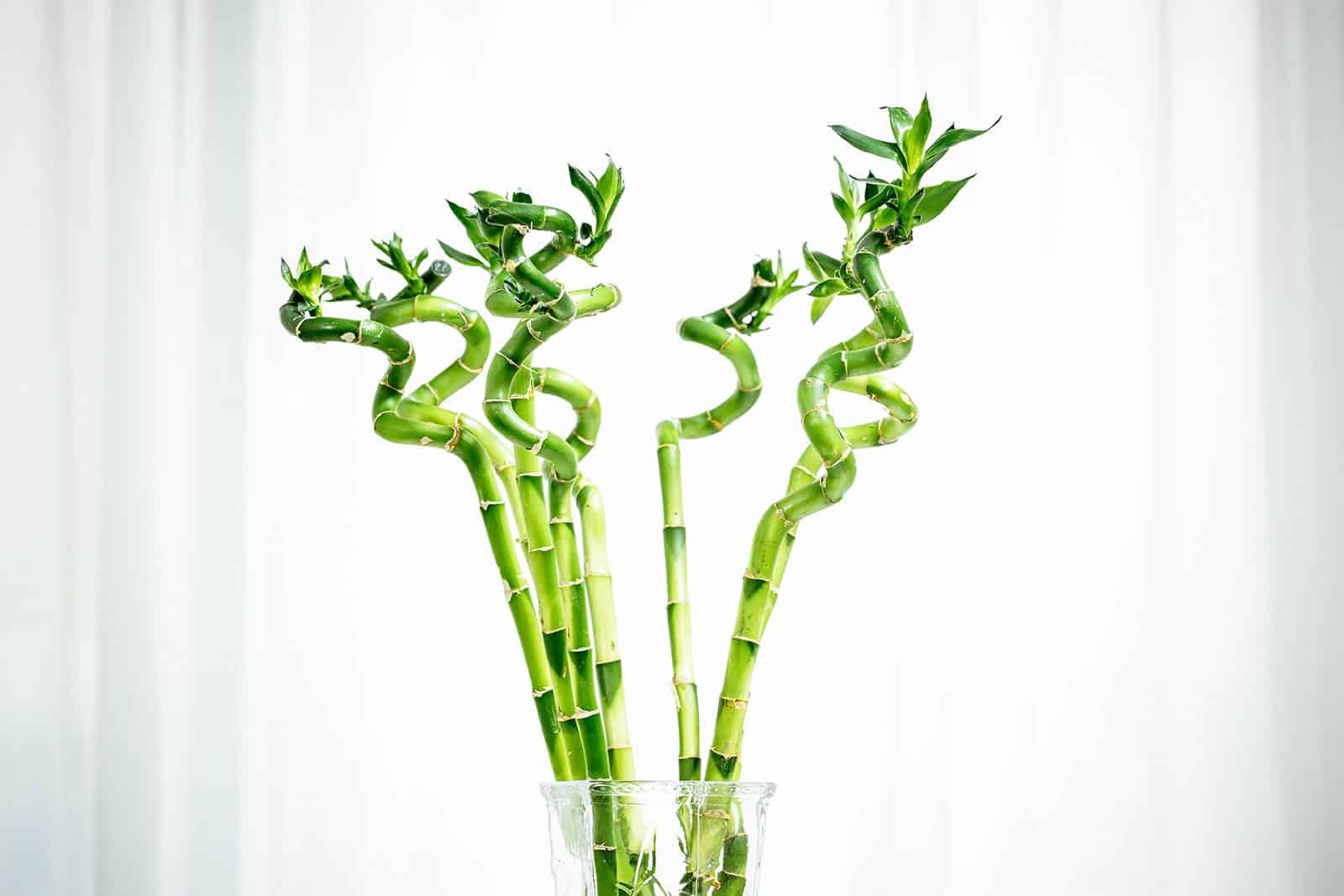Looking for an easy houseplant that can even be grown in water? Or have you received what looks like a little bamboo plant as a gift?
Lucky bamboo is one of the most popular houseplants worldwide, and for good reason. You’ll love growing this undemanding species in your own home.
Keep reading for everything you need to know about lucky bamboo and how to keep yours happy and healthy!
| Common name(s) | Lucky bamboo, curly bamboo, Sander’s Dracaena |
| Scientific name | Dracaena sanderiana |
| Family | Asparagaceae |
| Height and spread | Up to 4 feet high and 1 foot wide |
| Light | Bright indirect |
| Soil type | Well-draining or soilless |
| Water | Let dry halfway |
Disclosure: If you shop from my article or make a purchase through one of my links, I may receive commissions on some of the products I recommend.

About lucky bamboo
Description
The first thing you need to know about lucky bamboo is that, despite its common name, this plant isn’t actually a member of the bamboo subfamily (Bambusoideae).
It instead belongs to the genus Dracaena, which is part of the asparagus family Asparagaceae. And that’s a good thing, because actual bamboo would be challenging to grow indoors. Plus, it gets huge!
Fun fact: Lucky bamboo isn’t the only surprising houseplant cousin to asparagus. Spider plants, snake plants, and cast iron plants are distantly related to the vegetable, too!
It’s easy to see where the confusion arose. Like real bamboo, lucky bamboo (Dracaena sanderiana) sports segmented green stems and a tuft of leaves near the top. A single stem on this shrubby plant can grow to up to 4 feet in length.
The lucky bamboo you’ll find for sale in your local plant store usually consists of one or multiple sections of stem. These are rooted at the bottom in water or soil.
While the tops are flat at first where the cut was made, the stem will quickly sprout new “heads” and continue growing, forming a new plant. Sometimes, a big bouquet of lucky bamboo stems is tied together in a gift arrangement.
How is lucky bamboo curled?
The spiraled lucky bamboo stems you’ll see for sale didn’t come about naturally. Instead, growers use an ingenious method based on the fact that plants will naturally grow towards the brightest light source.
They put the stems on their sides and then gradually rotate them to manipulate their growth direction, allowing them to create curls, braids, and twisted arrangements.
It looks great, but remember you’ll have to keep twisting the stems yourself after purchase, since new growth won’t curl by itself.
Did you know? Lucky bamboo (Dracaena sanderiana) is often confused with another, similar species called Dracaena braunii. Even some sales listings get it wrong, and a few scientific databases list the two as synonyms when they’re actually separate species! Unlike D. sanderiana, D. braunii isn’t all that commonly seen in horticulture.

Natural habitat
Although the “bamboo” name and the fact that it’s extensively grown in China seem to suggest that this is where this species is from, lucky bamboo is actually naturally found in Central Africa.
In countries like Angola, Cameroon, and Congo, Dracaena sanderiana can be found growing wild in what is called the wet tropical biome—basically rainforests. Here, the species forms part of the undergrowth.
Did you know? I occasionally see lucky bamboo sold for use as an aquarium plant. It looks quite nice in fish tanks, but unfortunately, it’s not made to be fully submerged for extended periods of time. Eventually, the plants always rot, which can cause water quality issues.
History
Dracaena sanderiana was first discovered by Western botanists during an expedition by Johannes M. Braun in Cameroon, which was then a German colony. He collected various Dracaena specimens, including one that would later be named after him (the aforementioned Dracaena braunii, which is often confused with lucky bamboo).
Braun sold some cuttings of one species to Henry Frederick Conrad Sander, a renowned German botanist living in England. These were the plants that would later become known as Dracaena sanderiana (or true lucky bamboo). They’ve been a staple in horticulture ever since, especially in China.
Cultural significance
The reason that lucky bamboo became so popular in China in particular is probably because bamboo itself has been a symbol of virtue and traditional Chinese values for thousands of years (much like another favorite houseplant, Pachira aquatica—also known as the money tree).
Since bamboo is difficult to grow indoors and the climate in much of the country is actually perfect for Dracaena, it’s not a surprise that lucky bamboo became the go-to replacement!
Lucky bamboo is a symbol in Feng Shui, representing wood with its stems and fire with the red ribbon that often ties arrangements together. Additionally, different amounts of stalks in an arrangement carry different meanings. According to most sources, it goes a little like this:
- 1 for good fortune
- 2 for luck (for instance, as a wedding gift)
- 3 for happiness
- 5 for health
- 7 for wealth
- 8 for prosperity
- 21 for general good blessings
You won’t see Chinese folks gifting arrangements of four stems: the number is considered an omen of bad luck, as its pronunciation is similar to the Cantonese word for “death.” Lucky bamboo sells particularly well around Chinese New Year (Lunar New Year), which typically takes place in late January or early February.
Did you know? Shipments of lucky bamboo from China to the houseplant export hub of The Netherlands have been associated with the accidental introduction of invasive mosquito species in northern Europe.
This can be a problem, because Asian tiger mosquito and Asian bush mosquito are possible carriers of diseases like West Nile virus and dengue fever. I hope nurseries are aware of this risk, because invasive disease-carrying mosquitoes are a growing problem in the US as well.

Lucky bamboo varieties
As with most houseplants, selective breeding and spontaneous mutations have led to a couple of different varieties of lucky bamboo. Originally, there was a green version and a single variegated one.
Now, you can come across a few different variegation styles, like:
- Dracaena sanderiana ‘Victory’: Two thin cream stripes on a green leaf
- Dracaena sanderiana ‘Gold’: Two broad golden stripes with green leaf center
- Dracaena sanderiana ‘Silver Ribbon’: Two thin cream stripes on the leaf edges
- Dracaena sanderiana ‘Lemon-Lime’: Light and dark green leaves.
The most striking differences in lucky bamboo plants aren’t the different types of variegation, though. It’s all in how an arrangement is presented!
You can get a single curled stem, straight stalks, braided sets, twisted groups, pyramid shapes, Christmas tree-like towers and even hearts. Some will be grown in soil, but most are maintained in water.
Where to buy lucky bamboo plants:

Caring for lucky bamboo
Light and temperature
As discussed, lucky bamboo isn’t a very demanding houseplant at all. In terms of light, because it naturally forms part of the rainforest undergrowth, it doesn’t need much and is a great choice if you’re looking for a truly low-light houseplant.
Bright indirect light, like close to a north-facing windowsill, is absolutely fine. Artificial light works as well.
In terms of temperature, the species is a bit more specific. It doesn’t mind intense heat as long as it’s not being scorched by the sun, but it doesn’t respond quite as well to cold.
Yours will likely begin to struggle if temperatures drop below 50°F. Frost will kill it outright so it’s not a plant to leave outside in colder regions. As a rule of thumb, if you feel comfortable in your home, then your lucky bamboo likely does as well.
Water and humidity
If you’re growing your lucky bamboo in water, then this section obviously doesn’t apply. You can head to my article on growing houseplants in water instead if you’d like to learn more about how to keep your plant happy in the long run.
If your plant is in soil, then don’t worry either. Dracaenas are known for being quite forgiving when it comes to soil moisture! They don’t tend to be the quickest growers and their fleshy stems store water well, so it’s usually best to take it relatively easy with the watering can.
I tend to let my Dracaenas dry out about halfway before watering again during the active summer growing months.
In winter, when plants use much less water, I leave them alone even longer. Sometimes I don’t water for up to a month!
Despite being a tropical rainforest plant that naturally grows in areas where the humidity will consistently be at 90 percent or up, lucky bamboo isn’t actually all too fussy about air moisture. Unless your home is very dry (consistently under 30 to 40 percent), there’s no need to pay extra attention to it in this department.
Soil and planting
Again, if you’re growing your lucky bamboo in water, you can feel free to skip this section. Can you see why I love soil-less grow methods? So much less to keep in mind for your plant’s health.
If you’re growing in soil, remember that drainage is an important factor for houseplants like Dracaena. They don’t like wet feet, and a soil type that retains water for too long can lead to root rot or even deadly stem rot in the long run!
Luckily, creating a basic soil mixture that allows excess water to escape is not difficult or expensive. All you need is a quality houseplant potting soil and some perlite. Mix 1 part perlite with 2 parts soil and you’ve got a perfect lucky bamboo planting medium.
In terms of planters, you can feel free to go with whatever type you like, though keep in mind that terracotta dries a bit quicker than plastic. Just make sure any planter you use has a drainage hole in the bottom.
Recommended products for lucky bamboo care:
- FoxFarm Ocean Forest Potting Soil
- Good Earth Organics Premium Potting Soil
- Perfect Plants Organic Perlite
Fertilizing
Although lucky bamboo doesn’t need much to thrive, it will appreciate some fertilizer from time to time to prevent yellowing leaves and slow growth.
For plants growing in water, you can buy special hydroponic lucky bamboo plant fertilizers. Use these according to the instructions on the bottle.
For Dracaenas growing in soil, any regular liquid houseplant fertilizer should work well. How often you should fertilize depends on factors like light level and season; in bright light environments in summer, you can do so up to once a month.
If your lucky bamboo is in a darker spot in the home, fertilizing only once or twice a year is probably best. Stop using plant food in winter, as the decreased light levels and lower temperatures mean most houseplant stop growing almost entirely until it warms back up.
Recommended fertilizers for lucky bamboo:
- Grow More Lucky Bamboo Fertilizer
- Super Green Lucky Bamboo Fertilizer
- Maxsea All-Purpose Seaweed Plant Food
- Houseplant Resource Center Liquid Fertilizer for Houseplants
Pruning
Like most houseplants, a lucky bamboo plant won’t really need to be pruned. You can remove dead leaves and also opt to trim any offshoots that you don’t like the look of, but more than that won’t be necessary.
Dividing or repotting
If you’re growing in soil and have a larger lucky bamboo arrangement that’s starting to outgrow its current container, you could consider splitting it up in order to repot each stalk separately.
I like to keep the sets together and just invest in a larger planter instead, though, since it just makes for a nicer look than solo stems.

Propagating lucky bamboo
As mentioned, lucky bamboo is multiplied by nurseries almost exclusively through the stem propagation method. Stems are chopped into segments and sealed with some wax to prevent fungal growth. Then the bottom is rooted while the top re-sprouts and voilà!
Sounds easy, right? That’s because it is! You can easily propagate lucky bamboo at home—for example, if one of the stalks on yours has grown a bit too long for your liking or you just want more plants.
The method is just like the one used at nurseries:
- Select a point on the stem where you want to make a cut. No leaves need to be included, so you can chop one stem into multiple segments as long as they’re at least 2 to 3 inches long each.
- You can also opt to remove one of the sprouts (“heads”) on a lucky bamboo plant for a propagation that doesn’t affect the look of the mother plant too much. Make sure the sprouts have a bit of stem of their own with at least one growth node.
- Make the cut using a sharp and clean knife.
- If growing in soil, apply some rooting hormone for quicker results (optional).
- Place the cutting in water or potting soil. Set the container in a light and warm (but not sunny) location. Be patient.
That’s it, there’s nothing more to it! It can take a while, but the cutting will grow its own root system and produce new leaf sprouts. The success rate for lucky bamboo cuttings is pretty high, so even a beginning houseplant enthusiast can do this.

Is lucky bamboo toxic to cats and dogs?
Lucky bamboo and other Dracaena species are considered mildly toxic to cats and dogs due to their saponin content. They can cause drooling, vomiting and a lack of appetite. If you think your furry friend has taken a bite, call your vet to ask whether they think you should take the animal in.
Interestingly, these plants are not toxic to humans, so they’re safe around children.
Sources:
https://powo.science.kew.org/taxon/urn:lsid:ipni.org:names:60471006-2
The Gardeners’ chronicle: a weekly illustrated journal of horticulture and allied subjects, ser.3: v.13: 445 (1893), f. 65
Damen, T. H., Van der Burg, W. J., Wiland-Szymańska, J., & Sosef, M. S. M. (2018). Taxonomic novelties in African Dracaena (Dracaenaceae). Blumea-Biodiversity, Evolution and Biogeography of Plants, 63(1), 31-53.
Foster, A. (2007). Roots of diversity: Growing culturally significant plants in the classroom. Green Teacher, (81), 24.
Ibáñez-Justicia, A., Koenraadt, C. J., Stroo, A., Van Lammeren, R., & Takken, W. (2020). Risk-based and adaptive invasive mosquito surveillance at lucky bamboo and used tire importers in the Netherlands. Journal of the American Mosquito Control Association, 36(2), 89-98.
View the Web Story on lucky bamboo plant care.















